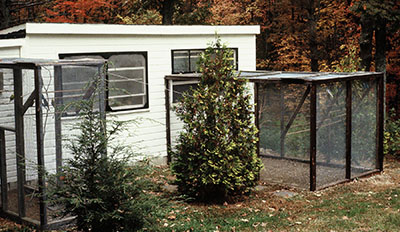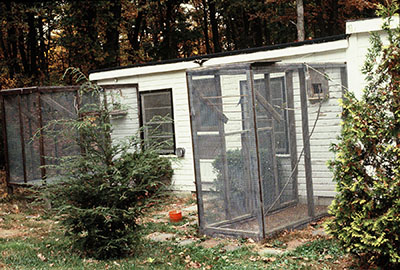
Don Langell talks about raising, breeding and maintaining top exhibition budgerigars in this 1998 interview.
Boxford, Massachusetts was home to who most
considered the top budgerigar breeder in America. In a large aviary outside
his country home 35 miles north of Boston, Don Langell raised his champion
birds for close to 50 years. He won many of the major shows in North
America, including several All- Americans, the premier annual show of the
American Budgerigar Society. The bloodlines from his aviary formed the
nucleus of many successful exhibition studs around the country. Years ago,
he was visited by Terry and Claire Pilkington. After the visit Terry dubbed
him “The King”, a nick-name well earned that stuck with him and is still
used today by those who remember him.


I met Don in 1981
when I judge Eastern Penn show in USA He had a large number of birds in the
top ten that day. He was years ahead of the time with his super birds. In
the years to come we became very good friends. Looking over his wonderful
stock, seeing his success get better and better, and to see and hear his
breeding successes, was really a time I enjoyed. ~ Eric
Peake
Your Light Green cock won the All-American in 1996.
Was that your first All-American win?
No. I have won it a few times in the past and there
have been times when eight of the top ten up there.
Did you place any other birds in the top 10 at the
1996 All-American?
Yes. I had four more out of the top ten up there.
Tell us about the background of the All-American
winner.
That’s one of my families. I have three families
working. It’s a well established family I’ve had for years out of Light
Green. I mixed the Grey-Green with them and it seemed to do very, very well.
I also had a son that placed second Best in Show at Statton Island.
When did you start breeding and exhibition
budgerigars?
When I was 25. Even as a kid I had pigeons, canaries,
budgerigars and rabbits. I needed something to fill a void so I got into
budgerigars again. I got in seriously because you’ve got to take it
seriously if you’re going to get anywhere.
How do the birds of today compare to top exhibits
when you first got started?
Oh my, today’s birds would bury the birds of years ago!
Although I did have a strain of birds, around 1980. And one of those
youngsters won an All-American then. He was a grey-green. Back then they
were ten years ahead of their time. People were calling them vultures. They
were massive with big heads, in my opinion gorgeous birds.
What is the origin of your birds?
That goes way back to Harry Bryan, Bob Miller and Tom
McCleary from Scotland and also Alf Ormerod. These are the guys I got birds
from to start, and they were very expensive then too. I’d say a bird you
paid $500 (GBP300) for in 1966, you’d pay $2000 (GBP1400) for if they’d sell
it today.
Where do you go to obtain a new bird to introduce to
your breeding program?
I don’t. I have these three families going back and
forth for years. And rarely consider going outside for a bird. There’s just
no need.
How do you describe your breeding program?
I line breed. I have found that to be pretty steady. To
line breed however the bird must have certain features. They must be of good
size. They must have a rough/buff feather. Their feet must be dark, not
pink, especially with the Cinnamons. There’s a lot of features people do not
recognize in the birds which is quite a challenge.
What do you suggest to beginners when buying stock?
Buy youngsters. Never buy old birds, always current
year birds, especially hens. Most breeders won’t sell a breeding hen. They
may offer a hen that looks great, but she’’ be a heck of a problem for you.
A hen you acquire between five and seven months of age will adapt. She’’ go
through a molt in your birdroom, she’’ adjust to your feeding, and by ten
months to a year she will be ready to breed. Old hens often don’t adjust.
They’ll never go near the nestbox, they may kill the cock or do some other
stupid thing. Old cocks are usually no problem, they adjust to anything.
What exhibition features are the hardest to maintain
or improve?
Style and head. A lot of people have a bird with a nice
head but it’s still a terrible bird with droopy wings, hinged tail,
humpbacks that don’t stand right. It’s got to have that head and the face,
and style and type. It is difficult and there is a lot to it, but the key is
line-breeding and selective mating. When you get a bird with problems, his
tail drops or he has a bad backline you just don’t keep it.

When do you breed your birds?
I like to start in March and finish up in November.
This year, for some reason, I’m still breeding and it’s January. The most
important thing people need to remember when breeding is that birds need
their rest. They must have their cycles. People will keep the lights on from
6AM until ten at night and that’s crazy. You’ve got to shorten their days,
let them go to sleep sexually for three or four months, from December to
February. Then you wake them up in March and you’ll be amazed.
What signs tell you the birds are ready to pair up?
Their sound. You don’t even have to look at them. You
can pick out a bird that makes a certain sound, especially the males. Then
watch the hens that are flying around, down picking around. The cocks will
turn their heads around and dilate their eyes, turn sideways and take off
like a cannon. The males will also start fighting, three or four tumbling to
the floor. They are ready! You’ve just got to sit and listen.
Do you find fertility suffers when the birds are
inbred or line bred?
I have no problem with fertility and never have. I
don’t go for inbreeding. I’ve tried it in the past and every now and then
get a brainstorm to try it, and it’s always a disaster. The chicks are never
anywhere near as good as the parents. It’s not like breeding rabbits or
horses where you breed the entire line off one sire. Budgies won’t breed
like that. I’ve tried all the angles, and I don’t breed father to daughter
or mother to son.
How many chicks do you breed in an average year?
Two hundred. I used to breed 350 but I’ve gotten old.


Who buys your excess birds, beginners or champion
breeders?
Everybody. Champions generally. As for price I will a
beginner what they can afford to pay. With a Champion it would take a lot
more, but I don’t like to shake up the beginners.
Do you find people buying your birds have success on
the show bench?
Tremendous success. I mean Best in Show winners. Many
have moved through the ranks to champion using my line.
What is your advice to people when buying breeding
stock?
Make sure you know what you are buying.
What should they expect to pay for top quality stock?
Generally, one to five hundred. It may sound a lot, but
it really isn’t when you consider you will pay four figures for similar
birds in England or Germany.
Do you have anything special
that you feed your birds?
I could go on and on about diet. I feed them
everything. Branches from trees, everything. You must keep in mind that all
they get is what you feed them and seed alone won’t do it. They eat more
than just seed in the wild, so I try to keep to nature as much as possible.
What about supplements?
Yes. I use lots of supplements, boiled eggs, fish meal,
meat and bone meal, monkey chow, minerals… all kinds.
Do you change your feeding program during the
breeding season?
No. My diet stays the same throughout the year. Some
guys will tell you that you must feed your birds hot stuff during breeding,
but the trick is to arrange a good solid diet from the start and stick with
it.
What do you do with sick birds?
When you see one that looks sick you must move fast
because they aren’t strong enough to last that way. You must learn how not
medicate. Learn how to use a syringe. If you use a tube syringe you will be
amazed how easy they take it in if you feed it slowly. Some guys use a
needle type but I find that risky and it can damage the bird,
What training do you give the young birds?
I don’t train any of them until they reach five
to six months then they go in the show cage. Never train hens. Don’t show
good hens…. Some won’t breed if you do.
At what age can you separate out the birds you will
keep from those that will be offered for sale?
Usually between six to eight months. My birds develop
and mature slowly but I can usually tell which ones I’ll keep and which ones
I’ll sell by then.
How have you personally benefitted from your
involvement in the hobby?
It has made me realize what a tremendous hobby we have.
There is so much to look forward to. I mean, we are creating beautiful
budgerigars. We’ve met so many excellent people and gained so many friends.
I love to go to shows and meet up with people we know. For years now, it has
been my pleasure and my goal to continually improve exhibition budgerigars
through quality breeding. So, if I am helping to do that, it is my greatest
personal benefit.
